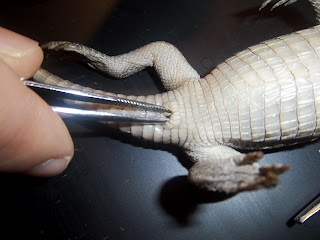The Crocodylia initially arose in the Late Cretaceous, although they are part of a larger clade that extends back into the Triassic. All have a relatively similar elongate body shape and possess variably elongate snouts toothed with thecodont teeth. Much of the crocodylian body is covered with osteoderms that are covered by keratinous scales. All 23 species of extant crocodylians are semiaquatic to aquatic, and use their muscular, laterally-compressed tails for swimming. All crocodylians are oviparous and exhibit parental care by building and guarding nests, and guarding the young once they hatch.

Postcranial Skeleton: Crocodylians have a postcranial skeletal anatomy that is fairly typical of reptiles. Their vertebrae can be divided into the cervical (vertebrae of the neck), thoracic (trunk vertebrae with ribs), lumbar (trunk vertebrae without ribs), sacral (vertebrae that articulate with the ilia), and caudal (tail) regions. The first cervical vertebra is referred to as axis, and it is this vertebra that articulates with the occipital condyles at the back of the skull and allows for up and down movement of the head. The second cervical vertebra, referred to as the axis, articulates with the atlas and allows for twisting of the head. The transverse processes of the ribs bear two articular surfaces that articulate with the two heads of the bicipital ribs. The diapophyses are the dorsal articular surfaces that articulate with the tubercula of the ribs, and the parapophyses are the more ventral surfaces that articulate with the capitula of the ribs. The limbs are composed of the typical elements of the tetrapod chiridium, and are anchored by the pectoral and pelvic girdles.

Cranial Skeleton: The skull of crocodylians exhibits the diapsid condition with two well-developed temporal fenestrae. The teeth of crocodylians are thecodont, meaning that they are set in sockets in the jaws. The three families within the Crocodylia have distinctive cranial morphologies that can be used to distinguish them. In gavialids, there is a long symphyseal articulation between the mandibles, the anterior processes of the surangular are of unequal lengths, the ectopterygoid abuts the maxilla at the tooth row margin, and the anterior process of the palatine extends anterior of the suborbital fenestra. In alligatorids, the symphyseal articulation between the mandibles is narrow, the anterior processes of the surangular are nearly equal, the ectopterygoid does not abut the maxilla at the tooth row margin, but is broadly separated from it, and the anterior process of the palatine extends anterior of the suborbital fenestra. In crocodylids, there is a narrow symphyseal articulation between the mandibles, the anterior process of the maxilla are of unequal length, the ectopterygoid abuts the maxilla at the tooth row margin, and the and the anterior process of the palatine does not extend anterior of the suborbital fenestra.

Morphology of the Snout:
It is possible to look at the anatomy and morphology of the snout to learn about the biology and diet of animals, such as crocodilians. Crocodilians that have broad and short snouts have greater crushing power, which can be used to kill a variety of prey, while narrower snouts are specialized for snapping fish out of the water (Gavialis).

Reproduction: Crocodilians exhibit internal fertilization and direct development of embryos. The egg shell of most crocodilians is pliable, but lack noticeable pores and shell elements. The male copulatory organ is referred to as a “penis” but is not homologous to a mammalian penis as it is only functional for sperm transfer. The cloaca is directed anteroposteriorly in crocodilians, unlike lizards and snakes that have a cloaca that is directed laterally.


Crocodilian Diversity:
Family Gavialidae (gharial and the false gharial): Gavialids have the most elongate and narrowest jaws of any extant crocodylians. There are only two extant species within this family, Gavialis gangeticus, and Tomistoma schlegelii. G. gangeticus tends to live in deep, fast-flowing rivers, where they primarily hunt fish. T. schlegelii is less well understood than G. gangeticus; however, T. schlegelii mainly ambushes waterside birds and mammals, rather than hunting fish.
Matěj Baťha (Wikipedia)
Family Alligatoridae (alligators and caimans): Alligatorids have broad, moderately long jaws, and all teeth of the lower jaw are enclosed within the mouth when shut. Alligatorids are opportunistic carnivores that occupy the Atlantic coast of southern North America, parts of Central and South America, and the lower reaches of the Yangtze River in China.
Josh Hillman (Florida Nature)
Family Crocodylidae (crocodiles and dwarf crocodiles): Crocodylids have moderately elongate jaws that are often fairly broad. The fouth tooth on the lower jaw lies external to the closed mouth, and the first tooth of the lower jaw may perforate the upper jaw and also be visible when the mouth is shut. They also possess well-developed salt glands. They are opportunistic carnivores found throughout the tropics.
Sam Abell (National Geographic)
Two possible cladograms representing the Crocodylia clade. The cladogram on the left represents the molecular tree, the one on the right represents the morphological tree.




No comments:
Post a Comment